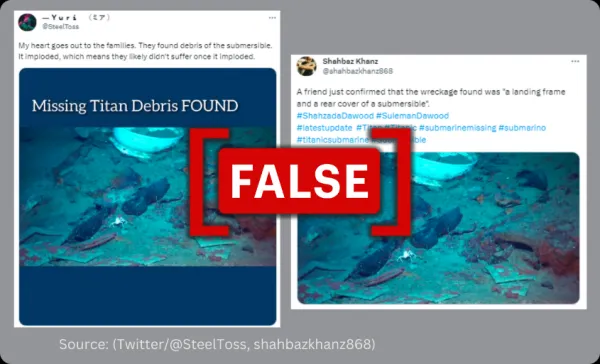By: Annet Preethi Furtado
June 27 2023
No, this image does not depict the wreckage of OceanGate's Titan submersible

The Verdict False
No official photos of the Titan's wreckage have been released. The photo of debris and shoes on the sea bed predate the Titan submersible incident.
Context
On June 22, debris of the Titan submersible, operated by OceanGate Expeditions, was found after a five day search-rescue-operation. Titan experienced a pressure loss, resulting in its implosion and the death of all five passengers on board, according to the U.S. Coast Guard.
Subsequently, multiple social media users shared a photo depicting debris on the ocean bed, including shoes and other objects, claiming that this photo represents the remains of the Titan submersible.
However, currently, there are no publicly available images of the wreckage of the Titan. Further, the viral image is from 2004.
In Fact
Last week, Coast Guard Rear Admiral John Mauger announced that a remotely operated vehicle (ROV) had discovered the wreckage of the Titan submersible on the seabed, approximately 1,600 feet away from the bow of the Titanic, reported The Washington Post
Reuters reported that five fragments belonging to the Titan were discovered within the debris field resulting from its disintegration. These findings included components such as the vessel's tail cone and two separate segments of the pressure hull. Notably, the report said there was no information or confirmation regarding human remains in the vicinity.
However, no images of the debris believed to be from the submersible have been released to the public. Neither the U.S. Coast Guard nor OceanGate has released such images. Furthermore, the media has not published any photographs depicting debris related to the incident.
On conducting a reverse image search, we discovered a news report by The Associated Press titled "Plan to retrieve Titanic radio spurs debate on human remains," published in 2020. The article carries the viral photo alongside three additional images, attributing it as an image from 2004 provided by “the Institute for Exploration, Center for Archaeological Oceanography/University of Rhode Island/NOAA Office of Ocean Exploration.” According to the report, the images show a coat and boots resting on the muddy seabed near the stern of the Titanic.
The viral image can also be found on the image-hosting platform Alamy. The caption accompanying the image also states that the image was captured in 2004. It further describes the shoes depicted in the image as belonging to one of the potential victims of the Titanic disaster.
What happened?
The Titan submersible disappeared shortly after it lost contact with its surface support ship on June 18. The incident occurred shortly before what should have been the end of the two-hour-long dive to explore the wreckage of the Titanic. The latter sank in 1912 and now rests at a depth of approximately 12,500 feet in the Atlantic Ocean. Aboard the submersible were five individuals: British businessman Hamish Harding, Pakistani British businessman Shahzada Dawood and his son Suleman Dawood, French deep sea explorer Paul-Henri Nargeolet, and OceanGate's chief executive Stockton Rush. Over five days, an extensive search-and-rescue operation was undertaken to locate the missing vessel.
The Verdict
No official photographs of the Titan submersible wreckage have been released to date. The viral image falsely circulated as the wreckage of the Titan submersible is, in fact, a photograph of shoes that once belonged to a potential victim of the Titanic tragedy in 1912. The image, captured in 2004, has been wrongly associated with the Titan submersible in 2023.


